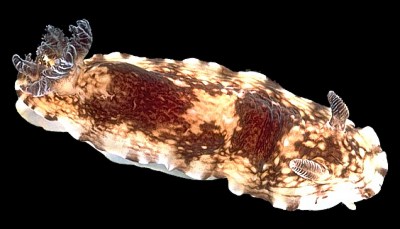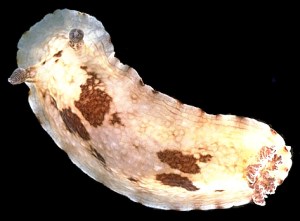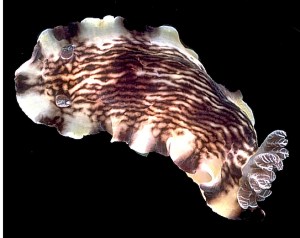
Aphelodoris greeni
Burn, 1966
Order: NUDIBRANCHIA
Suborder: DORIDINA
Superfamily: EUDORIDOIDEA
Family: Dorididae
DISTRIBUTION
Northern Tasmania, Australia [Burn, 1989]. Possible records here from eastern & southeastern Tasmania.
PHOTO
UPPER RIGHT: Bicheno, eastern Tasmania. 15m, 28mm long alive, May 1985.
LOWER LEFT: Bicheno, eastern Tasmania. 15m, 35mm long alive, May 1985.
LOWER RIGHT: Rocky Cape, NW Tasmania, 3m, 72mm long alive. median dark brown patches present but obscured by heavy brown lines. August 1985.
PHOTOS: Bill Rudman.
The body is creamy white with the foot bordered in yellow or orange. The are two large irregular brownish (maroon) patches in the midline and smaller brown or orange patches around the mantle edge. In some animals the bordering patches extend inwards some distance. Brown and/or orange streaks and spots are scattered elsewhere on the mantle, and sometimes a reticulate pattern can be seen outlining low rounded soft pustules on the mantle surface. Photographs here suggest its mantle ranges in colour from pale cream with some brown markings to forms in which the dark brown is the dominant colour. All the photographed animals had a pale translucent cream foot with a yellow border, and yellow tipped oral tenatcles.
Burn (1989) gives this species a distribution restricted to northern Tasmania. If my identifications are correct, the photos I have here from Bicheno in eastern Tasmania, and Nerida Wilson's records from eastern and southeastern Tasmania suggest a wider distribution at least in Tasmania. It is also very similar to an animal from Port Philip Bay, Victoria which I am temporarily labelling as Aphelodoris sp. 2.
This species distinctive features appear to be the two large brown median patches and the orange or brown patches around the mantle edge. The edge of the pale foot is lined in yellow or orange. Aphelodoris juliae Burn, 1966 was distinguished by Burn from A. greeni on colour differences and slight differences in radular morphology and the proportions of some reproductive organs. The main colour difference was the absence of prominent brown patches on the central part of the mantle. The two species were considered to have non-overlapping distributions, A. greeni from northern Tasmania, and A. juliae from south eastern Tasmania. From the photos it would seem A. greeni is found at least along the north and eastern coasts of Tasmania, and probably Victoria. A. juliae and A.greeni ar probably forms of the same species.
See Aphelodoris rossquicki for a further discussion on these southern Australian species of Aphelodoris.
References:
•Burn, R. (1966) Notes on opisthobranchs mainly from South Australia. Records of the South Australian Museum, 15: 329-352.
•Burn, R. (1989) Chapter 12. Opisthobranchs: 725-788. In: Marine Invertebrates of South Australia, Part 2. [Eds: S.A.Shepherd., I.M. Thomas]. South Australian Govt. Printing Office: Adelaide.


Rudman, W.B., 2000 (April 20) Aphelodoris greeni Burn, 1966. [In] Sea Slug Forum. Australian Museum, Sydney. Available from http://www.seaslugforum.net/factsheet/aphegree
Related messages
-
Re: Aphelodoris greeni (?) - Bicheno, Tasmania
From: John Silberberg, November 24, 2006 -
Re: Aphelodoris greeni (?) - Bicheno, Tasmania
From: Nerida Wilson, February 7, 2006 -
Aphelodoris greeni (?) - Bicheno, Tasmania
From: John Silberberg, February 3, 2006 -
Aphelodoris sp from Tasmania
From: Nerida Wilson, April 21, 2000 -
Aphelodoris in southeastern Australia
From: Bill Rudman, April 21, 2000
